1994 PONTIAC GRAND-AM lock
[x] Cancel search: lockPage 125 of 274
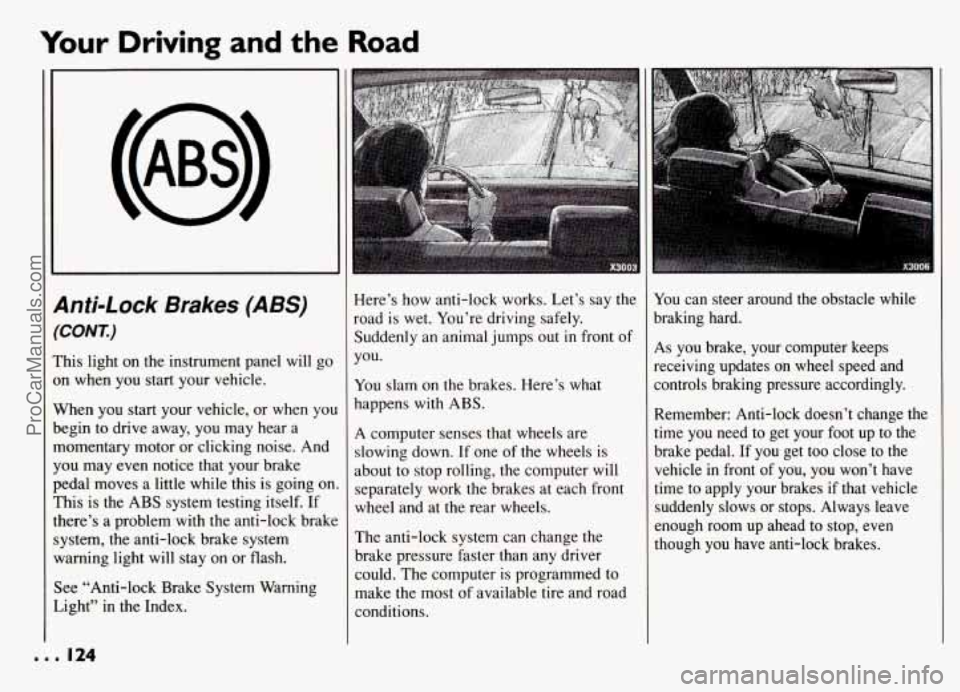
Your Driving and the Road
anti-Lock Brakes (ABS)
‘CONT.)
’his light on the instrument panel will go
In when you start your vehicle.
Nhen you start your vehicle, or when yo^
begin to drive away, you may hear a
nomentary motor or clicking noise. And
‘ou may even notice that your brake
edal moves a little while this
is going on
rhis is the ABS system testing itself.
If
here’s a problem with the anti-lock brakc
ystem, the anti-lock brake system
Yarning light will stay on or flash.
iee “Anti-lock Brake System Warning
ight” in the Index.
Here’s how anti-lock works. Let’s say the
road is wet. You’re driving safely.
Suddenly an animal jumps out in front of
you.
You slam on the brakes. Here’s what
happens with ABS.
A computer senses that wheels are
slowing down. If one of the wheels is
about to stop rolling, the computer will
separately work the brakes at each front
wheel and at the rear wheels.
The anti-lock system can change the
brake pressure faster than any driver
could. The computer is programmed to
make the most of available tire and road
conditions.
You can steer around the obstacle while
braking hard.
As you brake, your computer keeps
receiving updates
on wheel speed and
controls braking pressure accordingly.
Remember: Anti-lock doesn’t change the
time you need to get your foot up to the
brake pedal.
If you get too close to the
vehicle in front of you, you won’t have
time to apply your brakes
if that vehicle
suddenly slows
or stops. Always leave
enough room
up ahead to stop, even
though you have anti-lock brakes.
... 124
ProCarManuals.com
Page 126 of 274

To Use Anti-Lock:
Don’t pump the brakes. Just hold the
brake pedal down and let anti-lock work
.for you. You may feel the system
working, or you may notice some noise,
but this is normal.
Braking in Emergencies
Use your anti-lock braking system when
you need to. With anti-lock, you can steer
and brake at the same time. In many
emergencies, steering can help you more
than even the very best braking.
Steering
Power Steering
If you lose power steering assist because
the engine stops or the system is not
functioning, you can steer but it will take
much more effort.
Variable Effort Steering
(OPTION)
This steering system provides lighter
steering effort for parking and at low
vehicle speeds. Steering effort will
increase at higher speeds for improved
road feel.
Steering Tips
Driving on Curves
It’s important to take curves at a
reasonable speed.
A lot of the “driver lost control” accidents
mentioned on the news happen on curves.
Here’s why:
Experienced driver or beginner, each of
us is subject to the same laws of physics
when driving on curves. The traction of
the tires against the road surface makes it
possible
for the vehicle to change its path
when you
turn the front wheels. If there’s
no traction, inertia will keep the vehicle
going in the same direction. If you’ve
ever tried to steer a vehicle on wet ice,
you’ll understand this.
The traction you can get in a curve
depends on the condition of your tires and
the road ,surface, the angle at which the
curve is banked, and your speed. While
you’re in a curve, speed isthe one factor
you can control.
Suppose you’re steering through a sharp
curve. Then you suddenly accelerate.
Both control systems
-- steering and
acceleration
-- have to do their work
where the tires meet the road. Adding the
sudden acceleration can demand too
much of those places. You can lose
control.
What should you do if this ever happens?
Ease up on the accelerator pedal, steer the
vehicle the way you want it to go, and
slow down.
Speed limit signs near curves warn that
you should adjust your speed. Of course,
the posted speeds are based on good
weather and road conditions. Under less
favorable conditions you’ll want
to go
slower.
I
125...
ProCarManuals.com
Page 127 of 274
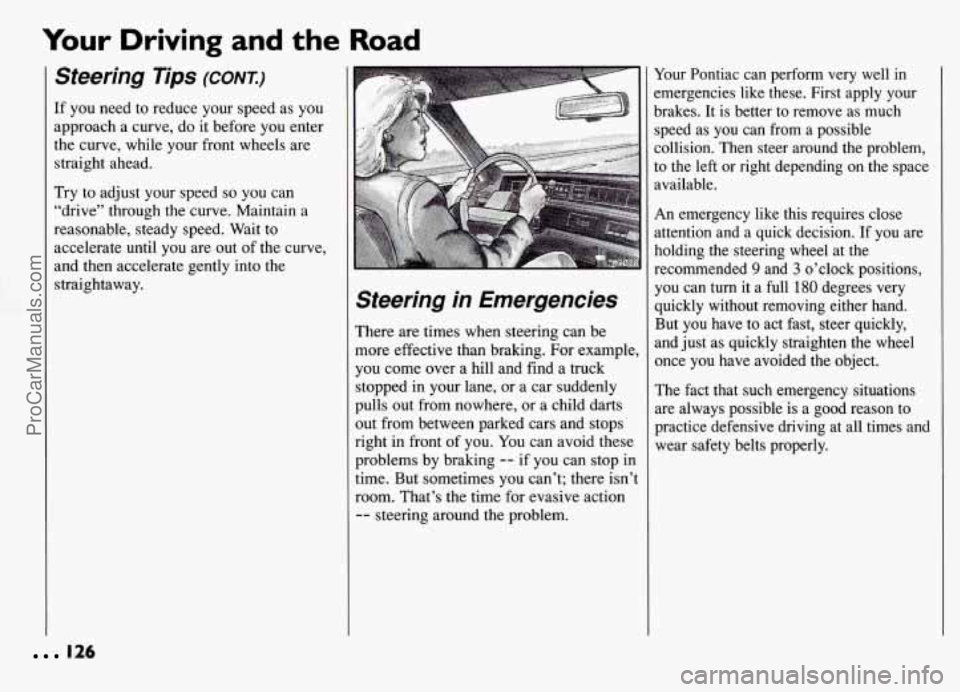
Your Driving and the Road
Steering Tips (CONT.)
If you need to reduce your speed as you
approach a curve, do it before you enter
the curve, while your front wheels are
straight ahead.
Try to adjust your speed so you can
“drive” through the curve. Maintain a
reasonable, steady speed. Wait to
accelerate until you are out of the curve,
and then accelerate gently into the
straightaway.
I .. ..
I
Steering in Emergencies
There are times when steering can be
more effective than braking. For example,
you come over a
hill and find a truck
stopped in your lane, or a car suddenly
pulls out from nowhere, or a child darts
out from between parked cars and stops
right in front of you. You can avoid these
problems by braking
-- if you can stop in
time. But sometimes you can’t; there isn’t
room. That’s the time for evasive action
-- steering around the problem.
Your Pontiac can perform very well in
=mergencies like these. First apply your
brakes. It is better to remove as much
speed as you can from a possible
Zollision. Then steer around the problem,
to the left or right depending on the space
mailable.
An emergency like this requires close
attention and a quick decision. If you are
holding the steering wheel at the
recommended
9 and 3 o’clock positions,
you can turn it a full
180 degrees very
quickly without removing either hand.
But you have to act fast, steer quickly,
and just as quickly straighten the wheel
once you have avoided the object.
The fact that such emergency situations
are always possible is a
good reason to
practice defensive driving at all times and
wear safety belts properly.
126
ProCarManuals.com
Page 130 of 274

Of course, traction is reduced when water, I
snow, ice, gravel, or other material is on
the road. For safety, you’ll want to slow
down and adjust your driving to these conditions. It is important to slow down
on slippery surfaces because stopping
distance will be longer and vehicle
control more limited.
While driving on a surface with reduced traction, try your best to avoid sudden
steering, acceleration, or braking
(including engine braking by shifting to a
lower gear). Any sudden changes could cause the tires to slide.
You may not?
realize the surface is slippery until your
vehicle is skidding. Learn to recognize
warning clues
-- such as enough water;
ice or packed snow on the road to make a
“mirrored surface”
-- and slow down
when you have any doubt.
Remember: Any anti-lock braking system (ABS) helps avoid only the braking skid.
I
Driving at Night
Night driving is more dangerous than day
driving. One reason is that some drivers
are likely to be impaired
-- by alcohol or
drugs, with night vision problems, or by
fatigue.
Here are some tips on night driving.
Drive defensively.
0 Don’t drink and drive.
Adjust your inside rearview mirror to
reduce the glare from headlights
behind you.
0 Since you can’t see as well, you may
need to slow down and keep more
space between you and other vehicles.
0 Slow down, especially on higher
speed roads. Your headlights can light
up only
so much road ahead.
In remote areas, watch for animals.
If you’re tired, pull off the mad in a
safe place and rest.
Night Wsion
No one can see as well at night as in the
daytime. But as we get older these
differences increase. A 50-year-old driver
may require at least twice as much. light to
see the same thing at night as a
20-year-old.
What you do in the daytime can also
affect your night vision. For example, if
you spend the day
in bright sunshine you
are wise to wear sunglasses. Your eyes
will have less trouble adjusting to night.
But
if you’re driving, don’t wear
sunglasses at night. They may cut down
on glare from headlights, but they also
make a lot of things invisible.
129...
ProCarManuals.com
Page 138 of 274
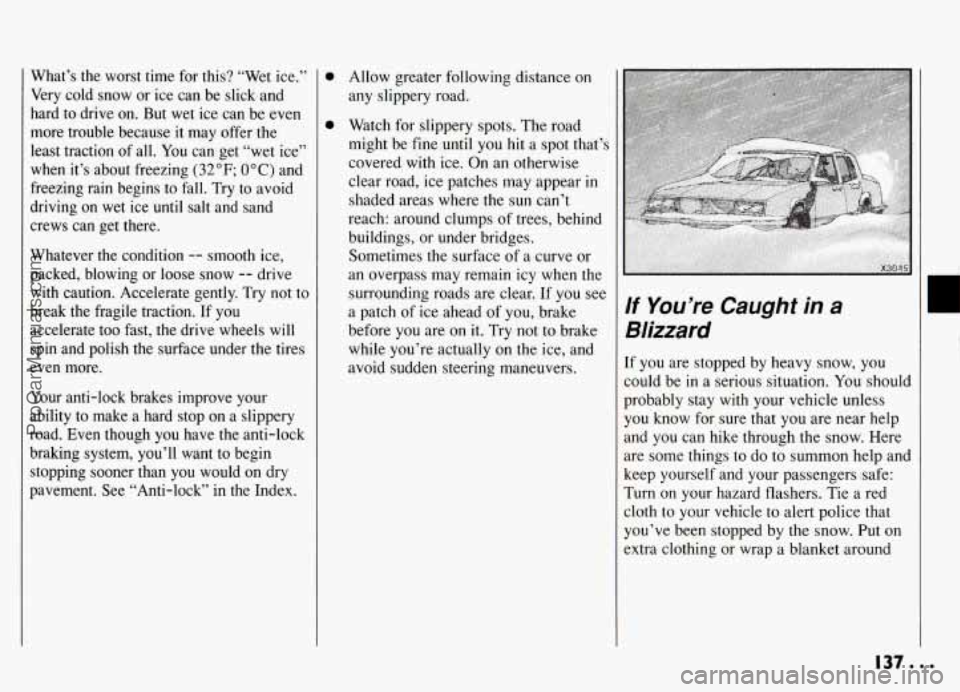
What’s the worst time for this? “Wet ice.”
Very cold snow or ice can be slick-and
hard to drive on. But wet ice can be even
more trouble because it may offer the
least traction of all. You can get “wet ice”
when it’s about freezing
(32°F; OOC) and
freezing rain begins to fall. Try to avoid
driving on wet ice until salt and sand
crews can get there.
Whatever the condition -- smooth ice,
packed, blowing or loose snow
-- drive
with caution. Accelerate gently. Try not to
break the fragile traction. If you
accelerate too fast, the drive wheels will
spin and polish the surface under the tires
even more.
Your anti-lock brakes improve your
ability to make a hard stop on a slippery
road. Even though you have the anti-lock
braking system, you’ll want to begin
stopping sooner than you would on dry
pavement. See “Anti-lock” in the Index.
0
0
Allow greater following distance on
any slippery road.
Watch for slippery spots. The road
might be fine until you hit a spot that’s
covered with ice. On an otherwise
clear road, ice patches may appear
in
shaded areas where the sun can’t
reach: around clumps of trees, behind
buildings, or under bridges.
Sometimes the surface
of a curve or
an overpass may remain icy when the
surrounding roads are clear. If you see
a patch of ice ahead of you, brake
before you are on it. Try not to brake
while you’re actually on the ice, and
avoid sudden steering maneuvers.
If You’re Caught in a
Blizzard
If you are stopped by heavy snow, you
could be
in a serious situation. You should
probably stay with your vehicle unless
you know for sure that you are near help
and you can hike through the snow. Here
are some things to do to summon help and
keep yourself and your passengers safe:
Turn on your hazard flashers. Tie a red
cloth to your vehicle to alert police that
you’ve been stopped by the snow.
Put on
extra clothing or wrap a blanket around
ProCarManuals.com
Page 140 of 274
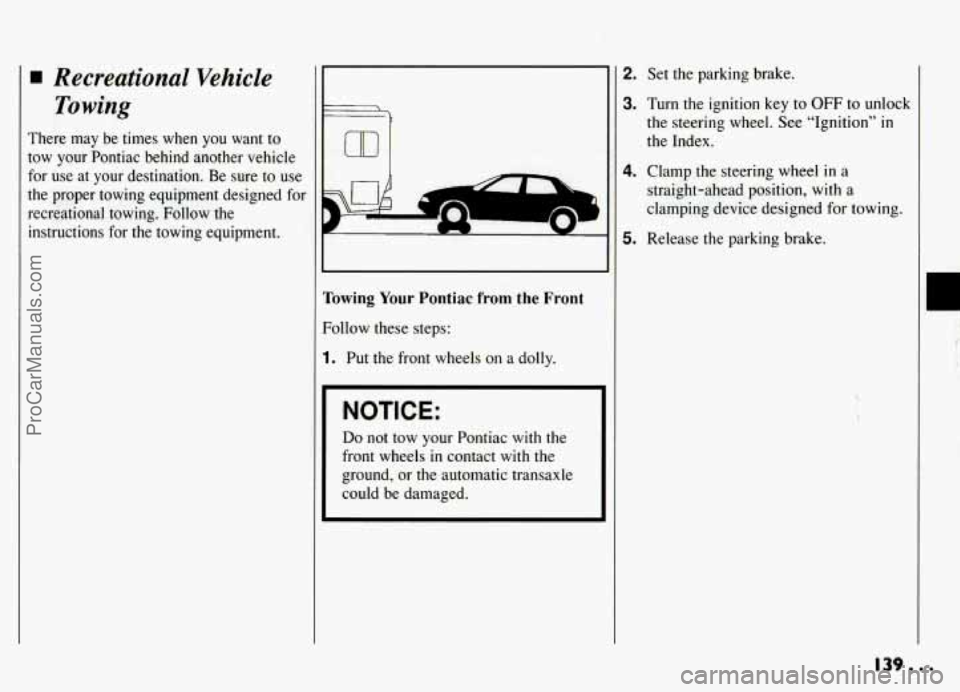
Recreational Vehicle
Towing
There may be times when you want to
tow your Pontiac behind another vehicle
for use at your destination. Be sure to use
the proper towing equipment designed for
recreational towing. Follow the instructions for the towing equipment.
-
Towing Your Pontiac from the Front
Follow these steps:
1. Put the front wheels on a dolly.
NOTICE:
Do not tow your Pontiac with the
front wheels in contact with the
ground, or
the automatic transaxle
could
be damaged.
2. Set the parking brake.
3. Turn the ignition key to OFF to unlock
the steering wheel.
See “Ignition” in
the Index.
4. Clamp the steering wheel in a
straight-ahead position, with a
clamping device designed for towing.
5. Release the parking brake.
C
139...
ProCarManuals.com
Page 144 of 274
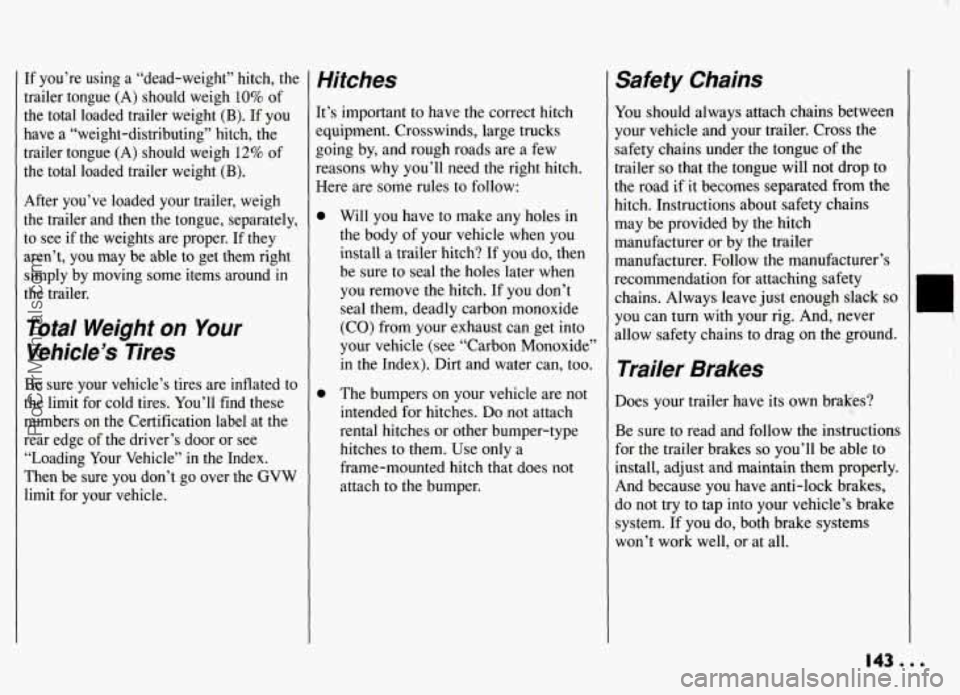
If you’re using a “dead-weight” hitch, the
trailer tongue
(A) should weigh 10% of
the total loaded trailer weight (B). If you
have
a “weight-distributing” hitch, the
trailer tongue
(A) should weigh 12% of
the total loaded trailer weight
(B).
After you’ve loaded your trailer, weigh
the trailer and then the tongue, separately, to see if the weights are proper. If they
aren’t, you may
be able to get them right
simply by moving some items around in
the trailer.
Total Weight on Your
Vehicle’s Tires
Be sure your vehicle’s tires are inflated to
the limit for cold tires. You’ll find these
numbers on the Certification label at the
rear edge of the driver’s door or see
“Loading Your Vehicle”
in the Index.
Then be sure you don’t go over the GVW
limit for your vehicle.
Hitches
It’s important to have the correct hitch
equipment. Crosswinds, large trucks
going by, and rough roads are a few
reasons
why you’ll need the right hitch.
Here are some rules to follow:
Will you have to make any holes in
the body
of your vehicle when you
install a trailer hitch? If
you do, then
be sure to seal the holes later when
you remove the hitch. If you don’t
seal them, deadly carbon monoxide
(CO) from your exhaust can get into
your vehicle (see “Carbon Monoxide”
in the Index). Dirt and water can, too.
The bumpers on your vehicle are
not
intended for hitches. Do not attach
rental hitches or other bumper-type hitches to them. Use only a
frame-mounted hitch that does not
attach to the bumper.
Sa#ety Chains
You should always attach chains between
your vehicle
and your trailer. Cross the
safety chains under the tongue of the
trailer
so that the tongue will not drop to
the road if it becomes separated from the
hitch. Instructions about safety chains may be provided by the hitch
manufacturer or by the trailer
manufacturer. Follow the manufacturer’s
recommendation for attaching safety chains. Always leave just enough slack
so
you can turn with your rig. And, never
allow safety chains to drag on the .ground.
Trailer Brakes
Does your trailer have its own brakes?
Be sure to read and follow the instructions
for the trailer brakes
so you’ll be able to
install, adjust and maintain them properly.
And because you have anti-lock brakes,
do not try to tap into your vehicle’s brake
system. If you do, both brake systems
won’t work well, or at all.
0
!
1
I I
!
143...
ProCarManuals.com
Page 154 of 274
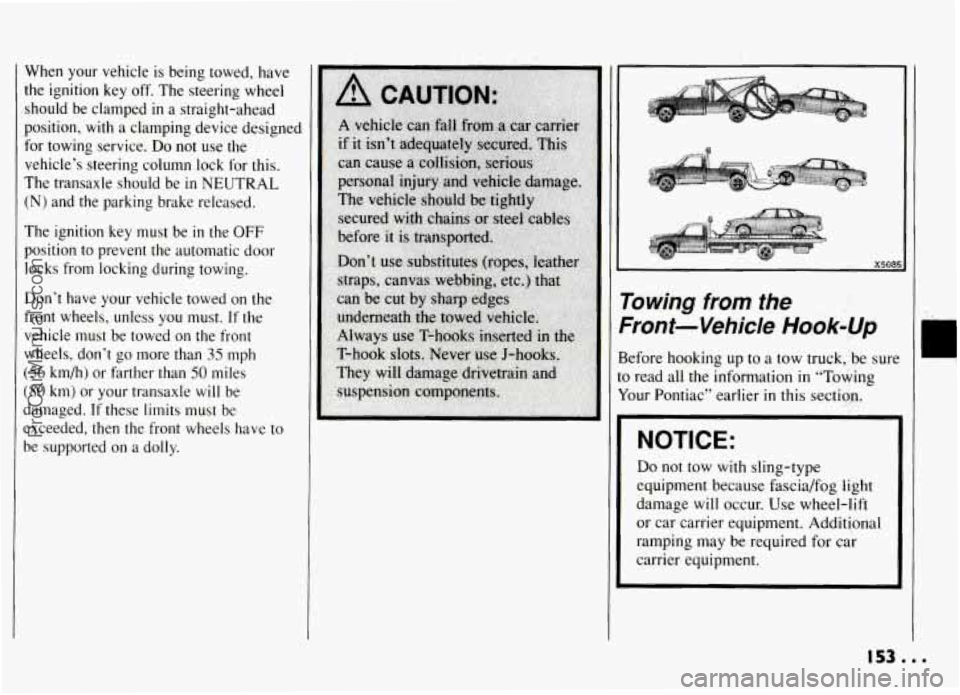
When your vehicle is being towed, have
the ignition key off. The steering wheel
should be clamped
in a straight-ahead
position,
with a clamping device designed
for towing service.
Do not use the
vehicle’s steering column lock for this.
The transaxle should be
in NEUTRAL
(N) and the parking brake released.
The ignition key must be in the OFF
position to prevent the automatic door
locks from locking during towing.
Don’t have your vehicle towed on the
front wheels, unless you must. If the
vehicle must be towed on the front
wheels, don’t go more than
35 mph
‘56 i. km/h) or farther than 50 miles
:SO km) or your transaxle will be
ilamaged. If these limits must be
:xceeded, then the front wheels have to
,e supported on a dolly.
,I 7
F
B
tc
Y
I
1
‘owing from the
?ont-Vehicle Hook-Up
efore hooking up to a tow truck, be sur(
1 read all the information in “Towing
our Pontiac” earlier
in this section.
NOTICE:
Do not tow with sling-type
equipment because fascia/fog light
damage will occur. Use wheel-lift
or car carrier equipment. Additional
ramping may be required for car
carrier equipment.
153...
ProCarManuals.com